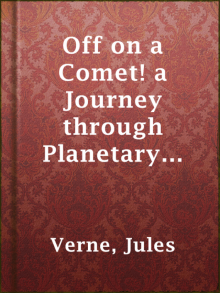


Off on a Comet! a Journey through Planetary Space
Jules Verne

Produced by Judy Boss
OFF ON A COMET or HECTOR SERVADAC
WORKS of JULES VERNE
Edited By Charles F. Horne, Ph.D.
Professor of English, College of the City of New York; Author of "TheTechnique of the Novel," etc.
[colophon omitted]
F. Tyler Daniels Company, Inc.
New York :::: London
Copyright, 1911 By Vincent Parke And Company
INTRODUCTION TO VOLUME NINE
_Among so many effective and artistic tales, it is difficult to give apreference to one over all the rest. Yet, certainly, even amid Verne'sremarkable works, his "Off on a Comet" must be given high rank. Perhapsthis story will be remembered when even "Round the World in Eighty Days"and "Michael Strogoff" have been obliterated by centuries of time. Atleast, of the many books since written upon the same theme as Verne's,no one has yet succeeded in equaling or even approaching it.
In one way "Off on a Comet" shows a marked contrast to Verne's earlierbooks. Not only does it invade a region more remote than even the"Trip to the Moon," but the author here abandons his usual scrupulouslyscientific attitude. In order that he may escort us through the depthsof immeasurable space, show us what astronomy really knows of conditionsthere and upon the other planets, Verne asks us to accept a situationfrankly impossible. The earth and a comet are brought twice intocollision without mankind in general, or even our astronomers, becomingconscious of the fact. Moreover several people from widely scatteredplaces are carried off by the comet and returned uninjured. Yet further,the comet snatches for the convenience of its travelers, both air andwater. Little, useful tracts of earth are picked up and, as it were,turned over and clapped down right side up again upon the comet'ssurface. Even ships pass uninjured through this remarkable somersault.These events all belong frankly to the realm of fairyland.
If the situation were reproduced in actuality, if ever a comet shouldcome into collision with the earth, we can conceive two scientificallypossible results. If the comet were of such attenuation, such almostinfinitesimal mass as some of these celestial wanderers seem to be, wecan imagine our earth self-protective and possibly unharmed. If, on theother hand, the comet had even a hundredth part of the size and solidityand weight which Verne confers upon his monster so as to give histravelers a home--in that case the collision would be unspeakablydisastrous--especially to the unlucky individuals who occupied the exactpoint of contact.
But once granted the initial and the closing extravagance, the departureand return of his characters, the alpha and omega of his tale, howclosely the author clings to facts between! How closely he follows, andimparts to his readers, the scientific probabilities of the universebeyond our earth, the actual knowledge so hard won by our astronomers!Other authors who, since Verne, have told of trips through the planetaryand stellar universe have given free rein to fancy, to dreams of whatmight be found. Verne has endeavored to impart only what is known toexist.
In the same year with "Off on a Comet," 1877, was published alsothe tale variously named and translated as "The Black Indies," "TheUnderground City," and "The Child of the Cavern." This story, like"Round the World in Eighty Days" was first issued in "feuilleton" by thenoted Paris newspaper "Le Temps." Its success did not equal that of itspredecessor in this style. Some critics indeed have pointed to this workas marking the beginning of a decline in the author's power of awakinginterest. Many of his best works were, however, still to follow. And, asregards imagination and the elements of mystery and awe, surely in the"Underground City" with its cavern world, its secret, undiscoverable,unrelenting foe, the "Harfang," bird of evil omen, and the "firemaidens" of the ruined castle, surely with all these "imagination" isanything but lacking.
From the realistic side, the work is painstaking and exact as all theauthor's works. The sketches of mines and miners, their courage andtheir dangers, their lives and their hopes, are carefully studied. Soalso is the emotional aspect of the deeps under ground, the blackness,the endless wandering passages, the silence, and the awe._














